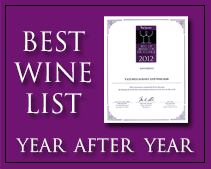Grape varieties of wines produced in Tuscany, Italy
Date: December 25, 2010
About Wines from Tuscany, Italy
Best wine supplier in Philippines discusses wine related topics
Origins:
Grape variety already cited by Pier De’ Crescenzi (1303). There has been some disagreement as concerns its origins: there are those who believe it originates from Greece, and those who consider it most likely a Tuscan variety, probably obtained through a dark-berried mutation of the black muscat.
Characteristics:
Large pentagonal and orbicular leaf, tri-lobed, smooth, dark green face. Small, elongated loose cluster, with a single shoulder. Medium-sized, discoid berry, very irregular in shape, transparent, blue vermilion skin, with a heavy bloom.
Aleatico is generally cultivated on the Isle of Elba, and the result is a delicious dessert wine.
Productivity: Medium and constant.
Maturation: from the 20th to the 30th of September
CANAIOLO NERO
Origins:
of uncertain origins, although it has been known for centuries. The grape variety appears as Vitis Vinifera Etrusca and Canajuola in Pier de Crescenzi’s “Opus Commodorum Ruralium” (Treatise on the Rural Management), first published towards 1303.
Along with Sangiovese, it was, in the century between 1870 and 1970, the basis of the blend of Chianti Classico, the other Chianti-style wines produced in a substantial part of the territory of Tuscany, and of Vino Nobile di Montepulciano.
Characteristics:
Small to medium-sized leaf with five lobes, sometimes with three lobes, with an upper surface marked by veins, opaque and dark green in color. Medium-sized clusters, some what loosely put together, squat, and pyramid shaped, with one or two shoulders or side bunches with a sparse distribution of grapes. Medium-sized, sub-round berries, regular in shape, fairly thick skin, blue or sometimes violet in color, with a rich bloom.
Less intense and structured than Sangiovese, it compensates with much aromatic elegance, a direct and expressive fruitiness, and a lovely softness of texture. When cultivated to give the proper body and concentration, it gives a wine of much individual character, one with a personality that is immediately distinctive and perceptible and with good length and persistence on the palate.
Productivity: medium to abundant, although inconstant.
Maturation: fairly late, towards the end of September.
CILIEGIOLO
Origins:
Of uncertain origin, even if it appears to have reached Tuscany from Spain in 1870. The first documented references to the variety are from the early 17th century when the Florentine writer Soderini described a “Ciregiuolo dolce” with a long bunch, a somewhat large berry, and a sweet – “dolce” – and fragrant flavor. This description of the physical characteristics of the variety corresponds to present-day Ciliegiolo, as does the observation that the grape does best in notably warm climates.
The variety has aroused new interest and attention since the late 1980’s and early 1990’s as new wines, made with an altogether different approach, began to demonstrate that the grape could reach new, and unexpectedly high quality, levels. The grape is used to blend with for example Sangiovese, but has also been used on its own giving startlingly different results: wines of important size and weight, warm, generous, long, and authoritative.
Characteristics:
Average to large leaf, pentagonal, with either three lobes or five lobes, upper surface smooth and dark green. The cluster is large, fairly compact or compact, long cylindrical, pyramid shaped, with side bunches. The berries are medium-large, round or slightly round, skin of average thickness, of a black to purple color, with a heavy bloom.
Productivity: Abundant and consistent.
Maturation: Second half of August.
COLORINO
Origins:
Of remote origin, probably derived from the selection of some wild grape vines. Widely grown in Tuscany, in the area of Valdarno, Val d’Elsa and in the Val di Pesa. Its name comes from the deep color of the skin.
Characteristics:
Orbicular leaf, occasionally pentagonal, average, small leaf, three lobes or five lobes, with an upper surface which is lightly crimped and dark green. The clusters are small to average sized, slightly loose, cone-shaped, with side bunches or one or two shoulders. The berries are small-to-medium sized. The skin is thick, of a blackish to deep purple color, rich with bloom.
Colorino is generally used to blend with other varieties. It gives, as the name suggests, a good color to the wine.
Productivity: about average but consistent.
Maturation: last ten days of September.
MALVASIA BIANCA LUNGA
Origins:
a vine variety which has been cultivated for several centuries and is widely grown on the Chianti hills, from where it is held to originate.
Characteristics:
average sized to large leaf, pentagonal, with five lobes, with a smooth upper surface, of a deep green color. It has large clusters, compact, elongated, pyramid shaped, normally with two side bunches. Medium to small sized berries, spherical, regular form; with a skin which is resistant to breaking, with a straw yellow color with greenish streaks or golden yellow, with a rich bloom.
The use of Malvasia Bianca is today limited (since white grapes are no longer allowed in the Chianti Classico docg) to very few wines, but it is elementary to the traditional Tuscan dessert wine, Vin Santo, which is made also with Trebbiano Toscano.
Productivity: Abundant and consistent.
Maturation: First ten days of September.
PRUGNOLO GENTILE (SANGIOVESE GROSSO)
Origins:
Its origins can be traced back to the Sangioveto variety, which it differs from in some aspects. It is held to be indigenous to the commune of Montepulciano, in the province of Siena and was already described in the 18th Century as “Pigniuolo Rosso”.
Characteristics:
Medium-sized leaf, with five lobes, and a smooth upper surface. The clusters are medium-sized, in the shape of an elongated cylinder. The clusters are compact and have side bunches. The berries are medium-large, and ovoid. The skin of the berries is thin but resistant to breaking, of a blue-purplish color, covered with a rich bloom.
The Prugnolo Gentile/Sangiovese Grosso or “Brunello” grape is fundamental to the areas of Montalcino and Montepulciano and is now also being cultivated in several other areas of Tuscany. Comparted to the Sangiovese Piccolo, the Sangiovese Grosso has larger, more loosely bunched grapes, and thicker grape skins.
Maturation: End of September, beginning of October.
SANGIOVESE (SANGIOVESE PICCOLO)
Two families of Sangiovese grapes are known:
1) One with a large berry or which is also called dolce (sweet) and gentile (well-bread), whose synonyms are indeed Sangiovese Grosso, Prugnolo Gentile, Brunello di Montalcino.
2) The other family has small berries, and is also called forte (strong) or montanino (Tuscan for from the mountain and sometimes meaning rough) and among the various synonyms, Cordisco, Morellino, Uva Tosca, Primutico, San Vicetro, Sangiovese dal Cannello Corto di Predappio.
This Sangiovese is the variety that is mainly used for the Chianti wines.
The name of the Sangiovese red grape is thought to be derived from “sanguis Jovis” meaning “the blood of Jove (Jupiter).”
Origins:
the Sangiovese is one of the most ancient Italian grape varieties, and is certainly one of the most widely grown as well as the grape which quality-wise offers the best wines in Italy. All ampelographers agree that the grape originated in Tuscany.
Characteristics:
medium-sized leaf, longer than wide, with five or three lobes, the upper surface is smooth and hairless, of a light green color. The cluster is of medium-large sized, but also can also be small according to the variety, compact, taking a cylindrical-pyramid form, winged with one or two side bunches. Medium-sized berries, flattened, almost ellipsoid, with a substantial skin, of a blackish-purple color with a heavy bloom.
Productivity: Considerable.
Maturation: First half of October.
TREBBIANO TOSCANO
Origins:
the grape variety is of Etruscan origin. Trebbiano Toscano, perhaps the most important of the many “Trebbiani”, already cited Pliny the Elder, as “Trebulanum”, perhaps owes its name to the site of the same name of ancient Etruria, near Luni, at the border between Liguria and Tuscany or the Trebbia River of the Piacentini Hills. This is among the most widely grown grape varieties at the national level even if it finds chiefly grown in Tuscany, Lazio and Umbria
Characteristics:
medium-large leaf, pentagonal, with five leaves, hairless, upper surface, of an opaque, green color. Large clusters, (7-10 inches) (18-25 cm.) long, semi-compact, with side bunches. Medium-sized berries, discoid, of a rather regular shape; of average resistance to breakage, of a greenish yellow or pinkish yellow in color, according to the clones, with a more or less heavy bloom.
Trebbiano used to be one of the varieties that were blended into the Chianti Classico wines, but is now it goes into the simpler Chiantis, to make light white wines, and a fundamental variety in the Tuscan Vin Santo.
Productivity: very prolific and consistent.
Maturation: first three weeks of October.
VERNACCIA DI SAN GIMIGNANO
Origins:
even if the first documentation we have goes back to the year 1276, it is certain that it was previously imported either from the Cinque Terre region (Liguria), or from Spain or Greece. The Vernaccia di San Gimignano wine was praised by Sante Lancerio, cellar man of the Pope Paolo III and celebrated in the verses by Francesco Redi. It has become popular again only in the past few decades. Recent studies tend to show a clear distinction between this variety and Vernaccia varieties. The name Vernaccia derives from the Latin word “vernaculus” which means “of the place”, or “site”.
Characteristics:
orbicular or pentagonal shaped leaf, of average size, with three lobes. It has a large cluster, with a semi-compact elongated, aspect with pyramid like form, sometimes with side bunches. The medium-sized berries are almost discoid, round, with a skin of average thickness, and normally of a yellowish-green color.
The Vernaccia grape is exclusively grown in the San Gimignano region, hence the name of the grape and the wine match.
Productivity: Abundant and constant.
Maturation: September.
SOURCE: http://www.tuscany-wine.com/grape_varieties.htm
Are these articles useful for enhancing your wine and dine experience in the Philippines. Do they also help you with travel, leisure, vacation, dining out, nightlife and other leisure activities plans in Manila and other major cities of Philippines? Yats Restaurant hopes to provide you with ample information so you can plan your trips to Pampanga Angeles City Clark Freeport Zone whether you are travelling from Manila or other Asian countries such as Hong Kong, Shanghai, Singapore, Malaysia or Korea.
Restaurant reservations in Manila Philippines, planning of menu, selection of wine for dinner and booking a private function and event in Angeles City Clark Freeport Zone can all be handled. Yats Restaurant and Wine Bar has been regarded by many to be the premier restaurant north of Manila Philippines. Its 3000-line award-winning restaurant wine list has kept many wine lovers happy dining in this restaurant in Angeles City Clark Philippines for over a decade.
Yats Restaurant and Wine Bar was built by Hong Kong-based Yats International in 2000 to provide a world-class cozy fine dining restaurant, business meeting facilities and venues for private dinners and functions in Pampanga Angeles City Clark Freeport Zone. Pampanga Angeles City Clark Philippines was selected for this restaurant because of safety, clean air, absence of traffic and proximity to Manila and Subic.
For comments, inquiries and reservations, email Restaurant@Yats-International.com or call these numbers:
(045) 599-5600 0922-870-5178 0917-520-4401
Http://www.YatsRestaurant.com
Getting to this fine dining restaurant of Angeles City Clark Freeport Zone Pampanga Philippines
How to get to this fine-dining restaurant in Clark Philippines? Once you get to Clark Freeport, go straight until you hit Mimosa. After you enter Mimosa, stay on the left on Mimosa Drive, go past the Holiday Inn and Yats Restaurant (green top, independent 1-storey structure) is on your left. Just past the Yats Restaurant is the London Pub.
Restaurant waiters and servers aspiring to become good sommeliers in Philippines strive to earn a spot to train at the best wine restaurant in Philippines. Yats Restaurant and Wine Bar is well regarded by restaurants in Manila and Pampanga to be the best place to train to become a wine steward or sommelier. Yats is the only restaurant in the Philippines to earn the prestigious Best of Awards of Excellence for offering one of the best restaurant wine lists in the world.











